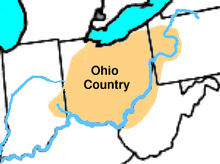Ohio Company

The Ohio Company, formally known as the Ohio Company of Virginia, was a
Formation
Virginian explorers recognized the potential of the Ohio region for colonization and moved to capitalize on it,
In addition to the mandate and investment of Virginia Royal Governor
The organizers signed a treaty of friendship and permission at Logstown with the main tribes in the region in 1752 .[8] A rival group of land speculators from Virginia, the Loyal Company of Virginia, was organized about the same time, and included influential Virginians such as Thomas Walker, William Cabell and Peter Jefferson (father of Thomas Jefferson).
In 1752 George Mason, later to become a major founding father, became treasurer of the Ohio Company, a post he held for forty years until his death in 1792.
French and Indian War
In 1748–1750, the Ohio Company hired
In 1750, the Ohio Company established a fortified storehouse at what became
Conflicting land claims complicated settlement efforts. The Ohio Country tract ceded by the King through Virginia's Governor Dinwiddie included, in Dinwiddie's opinion, the "forks of the Monongahela," present-day Pittsburgh. The Pennsylvania colonial government also claimed much of this territory (though Maryland's charter ended at the Appalachian divide, and while the charter of Virginia set no western boundary, Pennsylvania's grant was for 5 degrees of longitude from the Delaware River, a SW point not determined until after the Mason Dixon survey). Moreover, France also claimed land in North America, including everything drained by the Mississippi River (the Ohio River being one of the great river's tributaries). Not only did French traders compete with those of the Ohio Company and agents of other British-chartered entities, France had also sent soldiers, who were fighting for their kingdom's right to occupy the Ohio Valley, most notably at Fort Duquesne.[8] Dinwiddie responded by sending a military unit under the command of George Washington to the region,[9] which led to the outbreak of the French and Indian War.
Post-war efforts
In 1763, the Ohio Company sent a representative to petition the British Crown for a grant renewal. The plans for settlement and military development continued, with
Grand Ohio Company

In 1768, the British government authorized
The Ohio Company of Associates was organized in 1786, composed largely of New England veterans who had certificates for land from Congress for their services during the Revolution.[16]
Notes
- ^ a b MacCorkle, William Alexander. "The historical and other relations of Pittsburgh and the Virginias". Historic Pittsburgh General Text Collection. University of Pittsburgh. Retrieved 12 September 2013.
- ^ a b Consolidated Illustrating Company. "Allegheny County Pennsylvania: illustrated". Historic Pittsburgh Text Collection. University of Pittsburgh. Retrieved 16 September 2013.
- ^ Rowland, Kate Mason. "The Ohio Company." The William and Mary Quarterly, vol. 1, no. 4, 1893, pp. 197–203, https://doi.org/10.2307/1939709. Accessed 8 May 2022.
- ^ Andrew Arnold Lambing; et al. "Allegheny County: its early history and subsequent development: from the earliest period till 1790". Historic Pittsburgh Text Collection. University of Pittsburgh. Retrieved 12 September 2013.
- ^ The Darlington Collection, Special Collections Department, University of Pittsburgh. University of Pittsburgh. Retrieved 12 September 2013.
- ^ Emilius Oviatt Randall, Daniel Joseph Ryan (1912). History of Ohio: The Rise and Progress of an American State, Volume 1. p. 216.
- ^ a b Ambler, Charles Henry. "George Washington and the West". Historic Pittsburgh Text Collection. University of Pittsburgh. Retrieved 20 September 2013.
- ^ a b c Thurston, George H. "Allegheny county's hundred years". Historic Pittsburgh General Text Collection. University of Pittsburgh. Retrieved 25 September 2013.
- ^ wvculture.org: "Instructions for George Washington", n.d. extracted from The Writings of George Washington, Volume II, by Jared Sparks (Boston: Charles Tappan, 1846), pages 184-186.
- ^ a b Buck, Solon J. "The planting of civilization in western Pennsylvania". Historic Pittsburgh Text Collection. University of Pittsburgh. Retrieved 19 September 2013.
- ^ "Native American". Encyclopædia Britannica Online Academic Edition. Encyclopædia Britannica Inc. Retrieved 19 September 2013.
- ^ Kelly, George Edward. "Allegheny County, a sesqui-centennial review". Historic Pittsburgh Text Collection. University of Pittsburgh. Retrieved 20 September 2013.
- ^ "Treaties of Fort Stanwix". Encyclopædia Britannica Online Academic Edition. Encyclopædia Britannica Inc. Retrieved 20 September 2013.
- ^ Volwiler, Albert T. "George Croghan and the westward movement, 1741–1782". Historic Pittsburgh Text Collection. University of Pittsburgh. Retrieved 19 September 2013.
- ^ One or more of the preceding sentences incorporates text from a publication now in the public domain: Chisholm, Hugh, ed. (1911). "Ohio Company". Encyclopædia Britannica. Vol. 20 (11th ed.). Cambridge University Press. pp. 31–32.
- ^ The Records of the Original Proceedings of the Ohio Company (1796, reprinted 2008)
References
- Abernethy, Thomas Perkins. Western Lands and the American Revolution. New York: Russell & Russell, 1959.
- Bailey, Kenneth P. The Ohio Company of Virginia and the Westward Movement, 1748–1792. Originally published 1939. Reprinted Lewisburg: Wennawoods Publishing, 2000. ISBN 1-889037-25-7.
- Procter, James, Alfred. The Ohio Company: Its Inner History. Pittsburgh: University of Pittsburgh Press, 1959.
- Randall, Emilius; Ryan, Daniel Joseph (1912). History of Ohio: the Rise and Progress of an American State. Vol. 1. New York: The Century History Company. p. 211.
- Mulkearn, Lois, ed. George Mercer Papers Relating to the Ohio Company of Virginia. Pittsburgh: University of Pittsburgh Press, 1954. Collection of many original documents, including Christopher Gist's journal.



